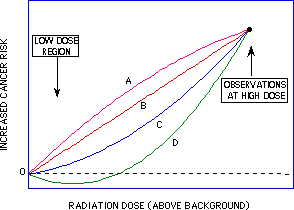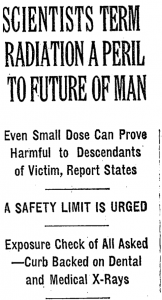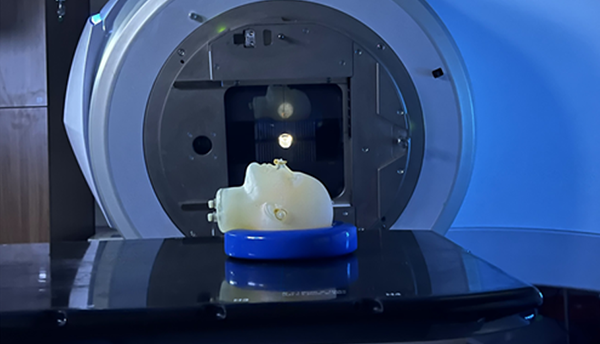Motives for pushing a no-threshold dose radiation risk model (LNT) in 1955-56
Dr. Edward Calabrese recently published a paper titled The Genetics Panel of the NAS BEAR I Committee (1956): epistolary evidence suggests self‐interest may have prompted an exaggeration of radiation risks that led to the adoption of the LNT cancer risk assessment model.
Abstract: This paper extends a series of historical papers which demonstrated that the linear-no-threshold (LNT) model for cancer risk assessment was founded on ideological-based scientific deceptions by key radiation genetics leaders. Based on an assessment of recently uncovered personal correspondence, it is shown that some members of the United States (US) National Academy of Sciences (NAS) Biological effects of Atomic Radiation I (BEAR I) Genetics Panel were motivated by self-interest to exaggerate risks to promote their science and personal/professional agenda. Such activities have profound implications for public policy and may have had a significant impact on the adoption of the LNT model for cancer risk assessment.
This new work was inspired when Calabrese found a 2007 history of science dissertation by Michael W. Seltzer titled The technological infrastructure of science. One facet of the paper is to explain how self-interest can create biases that affect scientific conclusions, policy setting, and public communications. Identical measurements and observations can be used to support dramatically different reports depending on what the scientists are attempting to accomplish.
That is especially true when there is difficulty at the margins of measurement where it is not easy to discern "signal" from "noise." The risk of agenda-driven conclusions has become greater as the scientific profession has expanded far beyond the sporadically funded idealists motivated by a pure search for knowledge, and into an occupation that provides "good jobs" with career progression, regular travel opportunities, political influence, and good salaries.
On the other hand, their efforts on the committee illustrate one component of the technological infrastructure of genetics outside of the laboratory: the increasing significance of large-scale laboratories, federal funding agencies, policy-making committees, and government regulatory bodies as critical components of the technological infrastructure of science. Clearly, how the science of genetics was to advance into the future would have much to do with traditionally non-epistemic factors, in addition to epistemic ones.Finally, in considering all these themes together, it is difficult to conclude that there is any sharp separation between the practice of science and the practice of politics (in the Foucauldian sense of power/knowledge). Rouse's view of the intra-twining of epistemology and power, his view of epistemic politics, is pertinent here. The practice of science was at times the playing of politically epistemic games, whether at the level of argumentation in the contestable theoretical disputes of population genetics, at the level of science policy-making, as with the various organizations and committees responding to the scientific and political controversies surrounding the efforts to establish exposure guidelines in the light of concerns over fallout from atomic testing, or with the planning of the future infrastructure of experimentation based on funding opportunities.
(Seltzer 2007, p. 307-308)
Admittedly, the language in the above quote uses jargon from the field of historians, but my translation is that Seltzer found ample evidence to support an assertion that the majority of geneticists on the BEAR I Genetics Panel were more concerned about fitting into a political narrative than they were in answering the questions they were ostensibly assembled to answer. Their tasking was to provide political decision-makers with scientifically supportable answers about the genetic effects of the radiation exposure that might be expected as a result of atomic weapons testing. However, they decided to complete a different task.
Some members of the committee had an agenda to assert the zero threshold dose response assertion desired by politically active members of the scientific community. They knew that answer-whether or not it was the truth-would assist their scientific colleagues in their efforts to raise concerns about fallout to a fever pitch. Fallout fear was their agreed-upon lever for gaining public support for their efforts to halt nuclear weapons testing.
Other members of the committee were more concerned about obtaining financial support for a long-term research program in general genetics research. That desired research program could only be tangentially related to determining the effect of the tiny, but chronic and largely unavoidable radiation exposures to human populations from highly dispersed atmospheric weapons testing fallout.
(Warning: If you are interested in the history of how the no-threshold dose assumption was imposed and you are pressed for time, please do not download Seltzer's paper and begin reading it. It is full of intriguing information, but it is 450 pages long including footnotes. The section on radiation health effects controversies is 112 pages long.)
Here is a quote from Calabrese's paper that does an excellent job of summarizing the important take-aways from Seltzer's historical research for people who are mainly interested in encouraging a new look at radiation protection assumptions and regulations:
Seltzer provided evidence that members of the Genetics Panel clearly saw their role in the NAS BEAR I committee to be a vehicle to advocate and/or lobby for funding for radiation genetics (p. 285 footnote 208). Moreover, it was hoped that the committee, which would exist continuously over many years, would influence the direction and priorities for future research funding. According to Seltzer (2007), such hoped for funding possibilities for radiation geneticists can be seen in letter correspondence between Beadle, Dobzhansky, Muller and Demerec....
Demerec responded by saying that "I, myself, have a hard time keeping a straight face when there is talk about genetic deaths and the tremendous dangers of irradiation. I know that a number of very prominent geneticists, and people whose opinions you value highly, agree with me" (Demerec to Dobzhansky 1957). Dobzhansky to Demerec (1957b) responded by saying "let us be honest with ourselves-we are both interested in genetics research, and for the sake of it, we are willing to stretch a point when necessary. But let us not stretch it to the breaking point! Overstatements are sometimes dangerous since they result in their opposites when they approach the levels of absurdity.
Now, the business of genetic effects of atomic energy has produced a public scare, and a consequent interest in and recognition of (the) importance of genetics. This is to the good, since it will make some people read up on genetics who would not have done so otherwise, and it may lead to the powers-that-be giving money for genetic research which they would not give otherwise." (Dobzhansky to Demerec (1957b)
Calabrese goes on to tie this newly uncovered history-of-science work to several other papers that he has recently published regarding his own excavation work digging through the collected papers of major players in the drama associated with using fears of radiation to slow and then stop nuclear weapons testing.
In retrospect, therefore, a historical assessment of the LNT reflects the so-called "perfect toxicological storm": Muller receiving the Nobel Prize within 1.5 years after the atomic bomb blasts in Japan, the deliberate deceptions of Muller on the LNT during his Nobel Prize lecture (Calabrese 2011a, 2012), the series of stealth-like manuscript manipulations and deceptions by Stern to generate scientific support for the LNT and to prevent Muller's Nobel lecture deceptions from being discovered (Calabrese 2011b), the series of subsequent false written statements by Muller to support Stern's papers and to protect his own reputation (Calabrese 2013), the misdirection and manipulation of the NAS Genetics Panel by the actions of Muller and Stern (Calabrese 2013), and now evidence of subversive self-interest within the membership of the Genetics Panel to exaggerate risk for personal gain. This series of Muller/Stern-directed actions inflamed societal fear of ionizing radiation following the bombings of Japan and during the extreme tensions of the cold war with its concomitant environmental contamination with radionuclides from atmospheric testing of nuclear weapons, and led to the acceptance of the LNT model for cancer risk assessment by a human population that had become extremely fearful of radiation, even at very low doses.
(Calabrese 2014 p. 3)
Though the scientist-led antinuclear weapons movement saw fear of fallout as one way of inciting public action to limit atmospheric weapons testing and its uncontrolled releases, other people might have had less admirable motives. There are many solid financial reasons to encourage people to fear all sources of ionizing radiation, especially the doses that members of the public could possibly receive from nuclear energy production.
After all, even in the 1950s, the fuel industry was one of the largest and most important businesses in the world and was the source of a number of enormous fortunes. The industry has always been interested in avoiding the unprofitably low prices that result when there are more energy options and when the total supply of available energy is greater than the immediate need.
When I spoke to Dr. Calabrese for Atomic Show #218, he indicated that he had not done much to find out where the BEAR I committee members thought they would be obtaining the funds that might be made available if they exaggerated the dangers of low dose radiation. Modern scientists often assume that basic scientific research funding comes from a government agency, but that is something that developed gradually after World War II. Before then, nearly all funding for science came from private sources.
A 1987 biography of Warren Weaver published by the National Academies of Science described the genesis of the NAS study of radiation started in 1955.
Paraphrasing the description on pages 506-507, in the United States one of the largest basic science funders was the Rockefeller Foundation. In 1954, there were numerous articles in the press indicating that the public was confused about the effects of radiation. At a Rockefeller Foundation board meeting, attendees asked Detlev W. Bronk, who was both a Rockefeller Foundation board member and the NAS president, if there was a way to produce some definitive answers.
The NAS proposed forming six committees to investigate various aspects of the issue and the Rockefeller Foundation agreed to provide the necessary funds to produce the reports. Warren Weaver served as the chairman of the Genetics Committee for the first BEAR reports. Of the other members of the committee, at least four (George W. Beadle, M. Demerec, H. J. Muller, and A. H. Sturtevant) had been recipients of Rockefeller Foundation grants before 1956 and several continued receiving substantial grants well after their work on the committee.
The NAS biography described Weaver's successful committee chairmanship:
The first committee was chaired by Weaver, who successfully mediated the opposing positions of the two groups of geneticists who were members of the committee and prepared a report that had their unanimous support. After the first summary report was published in 1956, there was virtual editorial unanimity in the nation's newspapers that the "report should be read in its entirety to be appreciated" and that it deserved the close attention of all concerned citizens.
Pages 506-507
In the June 13, 1956, edition of the New York Times, the news of the committee's report occupied the entire far right column of the front page from top to bottom. Here is the top portion of the article:
Below those scary, attention-grabbing phrases, the article's lead was designed to shock and raise serious concerns:
Washington, June 12 -- A committee of outstanding scientists reported today that atomic radiation, no matter how small the dose, harms not only the person receiving it but also all of his descendents [sic].
The article continued:
The six committees studied the radiation problem in the fields of genetics, pathology, meteorology, oceanography and fisheries, agriculture and food supplies, and disposal and dispersal of radioactive wastes.Overshadowing all others because of its implication for mankind was the report of the genetics panel. This was headed by Dr. Warren Weaver of the Rockefeller Foundation. It was this foundation that provided the funds for the year-long survey.
It is important to understand that the primary data that the genetics committee had available to review were from experiments using X-rays on fruit flies, most of which were conducted by foundation grantees and members of the committee.
It is also worth noting that Warren Weaver served as director for Natural Sciences for the Rockefeller Foundation from 1932-1959. During that period the program that he directed provided more than $90 million in grants for experimental biology. (NAS biography pg 504.) He had a distinguished career, received many awards, and had a major influence in selecting the science that was funded for molecular biology, radiation health effects, and genetics.
Weaver was a mathematician by education with a lifelong interest in statistics and Lewis Carroll's Alice in Wonderland. According to his obituary, he had the world's largest collection of various editions of the book. Upon his death, the collection was given to the University of Texas.
The Rockefeller Foundation was, and remains, interested in maintaining the dominance of oil and natural gas in our energy supply system. Those fuels were the source of the largess that the foundation has been able to give for more than 100 years.

_______________________

Adams
Rod Adams is a nuclear advocate with extensive small nuclear plant operating experience. Adams is a former engineer officer, USS Von Steuben. He is the host and producer of The Atomic Show Podcast. Adams has been an ANS member since 2005. He writes about nuclear technology at his own blog, Atomic Insights.







